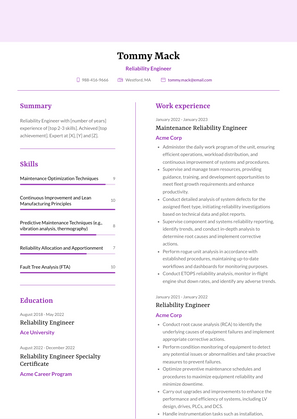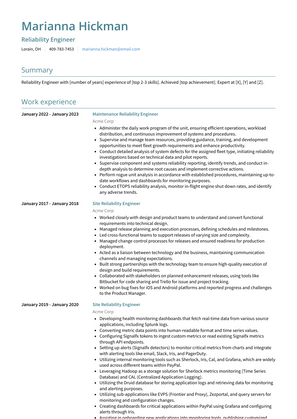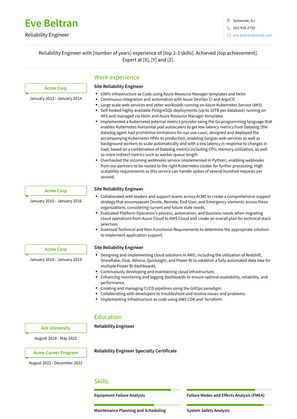Reliability Engineer Resume Examples and Templates
This page provides you with Reliability Engineer resume samples to use to create your own resume with our easy-to-use resume builder. Below you'll find our how-to section that will guide you through each section of a Reliability Engineer resume.



What Do Hiring Managers Look for in a Reliability Engineer Resume
- Strong knowledge of reliability engineering principles, methodologies, and practices to optimize the reliability and performance of systems, equipment, and processes.
- Proficient in conducting reliability analysis, including failure mode and effects analysis (FMEA) and root cause analysis (RCA), to identify potential failures and implement proactive measures.
- Skilled in developing and implementing preventive and predictive maintenance strategies to minimize unplanned downtime and improve asset reliability.
- Ability to analyze and interpret data, metrics, and trends to identify areas for improvement and drive reliability initiatives.
- Effective communication and collaboration skills to work with cross-functional teams and stakeholders, fostering a culture of reliability and continuous improvement.
How to Write a Reliability Engineer Resume?
To write a professional Reliability Engineer resume, follow these steps:
- Select the right Reliability Engineer resume template.
- Write a professional summary at the top explaining your Reliability Engineer’s experience and achievements.
- Follow the STAR method while writing your Reliability Engineer resume’s work experience. Show what you were responsible for and what you achieved as a Reliability Engineer.
- List your top Reliability Engineer skills in a separate skills section.
How to Write Your Reliability Engineer Resume Header?
Write the perfect Reliability Engineer resume header by:
- Adding your full name at the top of the header.
- Add a photo to your resume if you are applying for jobs outside of the US. For applying to jobs within the US, avoid adding photo to your resume header.
- Add your current position as a Reliability Engineer to the header to show relevance.
- Add your current city, your phone number and a professional email address.
- Finally, add a link to your portfolio to the Reliability Engineer resume header. If there’s no portfolio link to add, consider adding a link to your LinkedIn profile instead.
Bad Reliability Engineer Resume Example - Header Section
Marianna 7598 Old Manor St. Saugus, MA 01906 Marital Status: Married, email: cooldude2022@gmail.com
Good Reliability Engineer Resume Example - Header Section
Marianna Hickman, Saugus, MA, Phone number: +1-555-555-5555, Link: linkedin/in/johndoe
Make sure to add a professional looking email address while writing your resume header. Let’s assume your name is John Doe - here is a formula you can use to create email addresses:
- firstnamelastname@email.com - johndoe@email.com
- firstname.lastname@email.com - john.doe@email.com
- lastname.firstname@email.com - doe.john@email.com
- f.lastname@email.com - j.doe@email.com
- l.firstname@email.com - d.john@email.com
- firstnamelastname12@email.com - johndoe12@email.com
For a Reliability Engineer email, we recommend you either go with a custom domain name (john@johndoe.com) or select a very reputed email provider (Gmail or Outlook).
How to Write a Professional Reliability Engineer Resume Summary?
Use this template to write the best Reliability Engineer resume summary: Reliability Engineer with [number of years] experience of [top 2-3 skills]. Achieved [top achievement]. Expert at [X], [Y] and [Z].
How to Write a Reliability Engineer Resume Experience Section?
Here’s how you can write a job winning Reliability Engineer resume experience section:
- Write your Reliability Engineer work experience in a reverse chronological order.
- Use bullets instead of paragraphs to explain your Reliability Engineer work experience.
- While describing your work experience focus on highlighting what you did and the impact you made (you can use numbers to describe your success as a Reliability Engineer).
- Use action verbs in your bullet points.
Senior Systems Reliability Engineer Resume Example
Senior Systems Reliability Engineer
- Providing customer-centric support to GFT customers worldwide, assisting with deployments, management, and technical issues.
- Effectively handling account escalations and ensuring customer satisfaction by enhancing product serviceability.
- Serving as a performance subject matter expert (SME), specializing in database deployments.
- Proactively coaching and mentoring peers and beginners to enhance their skills and knowledge.
- Making significant contributions to the knowledge base by documenting best practices and troubleshooting techniques.
- Collaborating with the development engineering team to incorporate customer feedback and field implementations, driving product changes and improvements.
- Actively participating in defining product requirements (PRDs), new feature development, and beta testing.
- Leading support initiatives focused on improving Support NPS (Net Promoter Score) and customer satisfaction (CSAT).
Maintenance Reliability Engineer Resume Example
Maintenance Reliability Engineer
- Administer the daily work program of the unit, ensuring efficient operations, workload distribution, and continuous improvement of systems and procedures.
- Supervise and manage team resources, providing guidance, training, and development opportunities to meet fleet growth requirements and enhance productivity.
- Conduct detailed analysis of system defects for the assigned fleet type, initiating reliability investigations based on technical data and pilot reports.
- Supervise component and systems reliability reporting, identify trends, and conduct in-depth analysis to determine root causes and implement corrective actions.
- Perform rogue unit analysis in accordance with established procedures, maintaining up-to-date workflows and dashboards for monitoring purposes.
- Conduct ETOPS reliability analysis, monitor in-flight engine shut down rates, and identify any adverse trends.
Reliability Engineer Resume Example
Reliability Engineer
- Conduct root cause analysis (RCA) to identify the underlying causes of equipment failures and implement appropriate corrective actions.
- Perform condition monitoring of equipment to detect any potential issues or abnormalities and take proactive measures to prevent failures.
- Optimize preventive maintenance schedules and procedures to maximize equipment reliability and minimize downtime.
- Carry out upgrades and improvements to enhance the performance and efficiency of systems, including LV design, drives, PLCs, and DCS.
- Handle instrumentation tasks such as installation, calibration, and maintenance of flow, pressure, temperature, level, and density probes/transmitters.
- Design PID control loops to ensure optimal process control and stability.
- Prepare monthly reports on equipment performance and provide analysis of budget variances and accruals related to instrumentation and control systems.
Site Reliability Engineer Resume Example
Site Reliability Engineer
- Providing support and infrastructure for the infra, info-sec, and true-connect platforms.
- Conducting daily monitoring and time stamping of servers to ensure their smooth operation.
- Monitoring the health and disk-space utilization of Kafka servers.
- Utilizing Azure CI/CD pipeline for deployment and release activities in Azure DevOps.
- Installing Wazuh agent on servers and managing certification and keys.
- Creating ISR tickets and participating in server onboarding using tools like HPE.
- Setting up Grafana alerts and monitoring systems using Prometheus.
- Working with Apache Druid Server, including tasks such as server restarts, log checking, and live data ingestion and querying based on client requests.
Site Reliability Engineer Resume Example
Site Reliability Engineer
- Developing health monitoring dashboards that fetch real-time data from various source applications, including Splunk logs.
- Converting metric data points into human-readable format and time series values.
- Configuring Signalfx tokens to ingest custom metrics or read existing Signalfx metrics through API endpoints.
- Setting up alerts (Signalfx detectors) to monitor critical metrics from charts and integrate with alerting tools like email, Slack, Iris, and PagerDuty.
- Utilizing internal monitoring tools such as Sherlock, Iris, Cal, and Grafana, which are widely used across different teams within PayPal.
- Leveraging Hadoop as a storage solution for Sherlock metrics monitoring (Time Series Database) and CAL (Centralized Application Logging).
- Utilizing the Druid database for storing application logs and retrieving data for monitoring and alerting purposes.
- Utilizing sub-applications like EVPS (Frontier and Proxy), Zezportal, and query servers for monitoring and configuration changes.
- Creating dashboards for critical applications within PayPal using Grafana and configuring alerts through Iris.
- Assisting in onboarding new applications into monitoring tools, publishing customized metrics, creating customized dashboards, and setting up alerts.
Site Reliability Engineer Resume Example
Site Reliability Engineer
- Designing and implementing cloud solutions in AWS, including the utilization of Redshift, Snowflake, Glue, Athena, Quicksight, and Power BI to establish a fully automated data lake for multiple Power BI dashboards.
- Continuously developing and maintaining cloud infrastructure.
- Enhancing monitoring and logging dashboards to ensure optimal availability, reliability, and performance.
- Creating and managing CI/CD pipelines using the GitOps paradigm.
- Collaborating with developers to troubleshoot and resolve issues and problems.
- Implementing infrastructure as code using AWS CDK and Terraform.
Site Reliability Engineer Resume Example
Site Reliability Engineer
- Worked closely with design and product teams to understand and convert functional requirements into technical design.
- Managed release planning and execution processes, defining schedules and milestones.
- Led cross-functional teams to support releases of varying size and complexity.
- Managed change control processes for releases and ensured readiness for production deployment.
- Acted as a liaison between technology and the business, maintaining communication channels and managing expectations.
- Built strong partnerships with the technology team to ensure high-quality execution of design and build requirements.
- Collaborated with stakeholders on planned enhancement releases, using tools like Bitbucket for code sharing and Trello for issue and project tracking.
- Worked on bug fixes for iOS and Android platforms and reported progress and challenges to the Product Manager.
Senior Site Reliability Engineer Resume Example
Senior Site Reliability Engineer
- Planned and executed quarterly SRE (Site Reliability Engineering) goals to improve product and platform reliability.
- Led the UCMS (Unified Content Management System) project, including development, maintenance, bug fixes, and testing of React-based sites for all properties.
- Developed backend APIs using GQL (GraphQL) and configured WordPress CMS for the above-mentioned sites.
- Implemented end-to-end automated tests using Codecept.js as part of the ShiftLeft initiative.
- Managed product releases and troubleshooting of CI/CD pipelines.
- Improved site performance, implemented security patches, and worked on SEO-related improvements.
- Created and configured new environments using Infrastructure as Code (IAC) practices.
- Planned and executed migrations of services to new platforms.
- Engaged in Cloud Systems Engineering and Operations Management Planning.
- Created and maintained CI/CD pipelines and automated processes using CloudFormation and Lambda.
- Implemented a disaster recovery (DR) environment on AWS for AJ websites.
- Set up monitoring using tools like New Relic, PagerDuty, CloudWatch, etc.
Site Reliability Engineer Resume Example
Site Reliability Engineer
- Collaborated with leaders and support teams across ACME to create a comprehensive support strategy that encompasses Onsite, Remote, End-User, and Emergency elements across these organizations, considering current and future state needs.
- Evaluated Platform Operation's process, automation, and business needs when migrating cloud operations from Azure Cloud to AWS Cloud and create an overall plan for technical stack selection.
- Assessed Technical and Non-Functional Requirements to determine the appropriate solution to implement application support.
Site Reliability Engineer Resume Example
Site Reliability Engineer
- Crimson Automate Reliability Process Automation and Monitoring:
- Developed 10 reliability assurance robotic monitoring processes along with the pipeline to alert production support team on issues
- Contributed to the RPA community by creating 20+ reusable Crimson Automate modules.
Site Reliability Engineer Resume Example
Site Reliability Engineer
- 100% Infrastructure as Code using Azure Resource Manager templates and Helm
- Continuous integration and automation with Azure DevOps CI and ArgoCD
- Large scale web services and other workloads running on Azure Kubernetes Service (AKS)
- Self-hosted highly available PostgreSQL deployments (up to 10TB per database) running on AKS and managed via Helm and Azure Resource Manager templates
- Implemented a Kubernetes external metrics provider using the Go programming language that enables Kubernetes horizontal pod autoscalers to get low latency metrics from Datadog (the datadog agent had prohibitive limitations for our use-case), designed and deployed the accompanying Kubernetes HPAs to production, enabling Gorgias web services as well as background workers to scale automatically and with a low latency in response to changes in load, based on a combination of Datadog metrics including CPU, memory utilization, as well as more indirect metrics such as worker queue length
- Overhauled the incoming webhooks service (implemented in Python), enabling webhooks from our partners to be routed to the right Kubernetes cluster for further processing. High scalability requirements as this service can handle spikes of several hundred requests per second.
Top Reliability Engineer Resume Skills for 2023
- Reliability Analysis and Modeling
- Failure Modes and Effects Analysis (FMEA)
- Reliability Centered Maintenance (RCM)
- Root Cause Analysis (RCA)
- Asset Management and Optimization
- Preventive Maintenance Strategies
- Predictive Maintenance Techniques (e.g., vibration analysis, thermography)
- Reliability Testing and Evaluation
- Statistical Analysis and Data Interpretation
- Reliability Prediction and Life Cycle Analysis
- Risk Assessment and Mitigation
- Equipment Reliability Improvement
- Maintenance Planning and Scheduling
- Condition Monitoring and Diagnostics
- Asset Performance Management
- Maintenance and Repair Strategies
- Equipment Failure Analysis
- Reliability Metrics and Key Performance Indicators (KPIs)
- Failure Reporting, Analysis, and Corrective Action System (FRACAS)
- Reliability-Centered Design (RCD)
- Design of Experiments (DOE)
- Reliability Growth Analysis
- Reliability Block Diagram (RBD) Modeling
- Reliability Test Plan Development
- Maintainability Engineering
- System Safety Analysis
- Reliability Software Tools (e.g., ReliaSoft, MATLAB)
- Reliability Standards and Regulations
- Reliability-Centered Spare Parts Management
- Failure Data Collection and Analysis
- Reliability-Centered Inventory Management
- Maintenance Optimization Techniques
- Reliability Allocation and Apportionment
- Reliability Budgeting and Cost Analysis
- Failure Analysis Techniques
- Reliability Maintenance Strategies
- Reliability Verification and Validation
- Reliability Growth Testing
- Reliability Improvement Projects
- Maintenance Strategy Development
- Continuous Improvement and Lean Manufacturing Principles
- Reliability Training and Education
- Safety and Risk Management in Reliability Engineering
- Fault Tree Analysis (FTA)
- Reliability and Availability Simulation Modeling
- Human Reliability Analysis
How Long Should my Reliability Engineer Resume be?
Your Reliability Engineer resume length should be less than one or two pages maximum. Unless you have more than 25 years of experience, any resume that’s more than two pages would appear to be too long and risk getting rejected.
On an average, for Reliability Engineer, we see most resumes have a length of 2. And, that’s why we advise you to keep the resume length appropriate to not get rejected.
Copyright ©2025 Workstory Inc.
